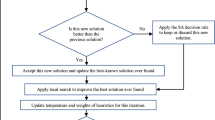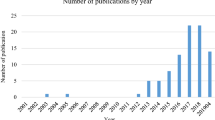Abstract
This paper conceptualizes a bidding-based multi-agent system for solving integrated process-planning and scheduling problem. The proposed architecture consists of various autonomous agents capable of communicating (bidding) with each other and making decisions based on their knowledge. Moreover, in contrast to the traditional model of integrated process-planning and scheduling problem, a new paradigm has been conceptualized by considering tool cost as a dynamic quantity rather than a constant. Tool cost is assumed to comprise tool-using cost and its repairing cost. The repairing cost is considered to depend on the tool-breaking probability, which is predicted by the data-mining agent equipped with the virtues of C-fuzzy decision tree. When a job arrives at the shop floor, the component agent announces a bid for one feature at a time to all the machine agents. Among the machine agents capable of producing the first feature, one comes forward to become a “leader”, and groups other machine agents for the processing of remaining features of the job. Once all features are assigned to the appropriate machines, the leader then sends this allocation information to the optimization agent. The optimization agent finds optimal/near-optimal process plans and schedules via the hybrid tabu-SA algorithm.
Similar content being viewed by others
References
Baker AD (1998) A survey of factory control algorithms that can be implemented in a multi-agent heterarchy: dispatching, scheduling and pull. J Manuf Sys 17(4):297–320
Bezdek JC (1991) Pattern recognition with fuzzy objective functions. Plenum Press, New York
Butler J, Ohtsubo H (1992) ADDYMS: architecture for distributed dynamic manufacturing scheduling. In: Famili A, Nau DS, Kim SH (eds) Artificial intelligence applications in manufacturing. AAAI Press/MIT press, Menlo Park, CA, pp 199–213
Clark P, Boswell R (1989) The CN2 induction algorithm. Mach Learn 3(4):261–283
Davis R, Smith R (1983) Negotiation as a metaphor for distributed problem solving. Artif Intel 20:63–109
Dornfeld D, Wright PK, Wang FC, Sheng P, Stori J, Sundararajan V, Krishnan N, Chu CH (1999) Multi-agent process planning for a networked machine service. Tech Paper - Soc Manuf Eng, MS99-175
Ferfuson D, Yemini Y, Nikolaou C (1988) Microeconomic algorithms for load balancing in distributed computer systems. IEEE Int. Conf. on Distributed Computer Systems, pp 491–499
Gu P, Balasubramanian S, Norrie DH (1997) Bidding-based process planning scheduling in a multi-agent system. Comput Ind Eng 32(2):560–573
Kadar B, Monostori L, Szelke E (1998) An object-oriented framework for developing distributed manufacturing architectures. J Intel Manuf 9(2):107–112
Kempenaers J, Pinte J, Detand J, Kruth JP (1996) A collaborative process planning and scheduling system. Adv Eng Softw 25(1):3–8
Kidd PT (1994) Agile manufacturing - forging new frontiers. Addison-Wesley, England
Kim KH (1997) A negotiation-based scheduling for items with flexible process plans. Comput Ind Eng 32(2):477–496
Kusiak A, Kurasek C (2001) Data-mining analysis of printed circuit board defects. IEEE Trans Robot Autom 17(2):191–196
Kusiak A, Shah S (2006) Data mining and warehousing in pharma industry. In: Wang J (ed) Encyclopedia of data warehousing and mining. Idea group, Inc., Hershey, PA, pp 239–244
Kusiak A (2006) Data mining: manufacturing and service applications. Int J Prod Res 44(18–19):4175–4191
Kusiak A (2001) Rough set theory: a data-mining tool for semiconductor manufacturing. IEEE Trans Electron Packag Manuf 24(1):44–50
Lim MK, Zhang Z (2000) An integrated agent-based approach for responsive control of manufacturing resources. The 27th Int. Conf. on Computers and Industrial Engineering ISBN 7-900043-38-1/TP., 38, No.55
Lim MK, Zhang Z (2000) Integrated manufacturing systems control using a multi-agent system. Proceedings of 33rd Int. MATADOR Conf. ISBN 1-85233-323-5, pp 9–14
Maione B, Naso D (2001) Evolutionary adaptation of dispatching agents in heterarchical manufacturing systems. Int J Prod Res 39:1481–1503
Pawlak Z (1991) Rough sets: theoretical aspects of reasoning about data. Kluwer Academic Publishers, Boston
Pedrycz W, Sosnowski A (2005) C-fuzzy decision trees. IEEE Trans Syst Man Cybern 34(4):498–511
Pedrycz W, Sosnowski ZA (2000) Desigening decision trees with the use of fuzzy granulation. IEEE Trans Sys Man Cybern, A Syst Humans 30(2):151–159
Quinlan JR (1986) Induction of decision trees. Mach Learn 1(1):81–106
Shah SC, Kusiak A (2004) Data mining and genetic programming-based gene/SPN selection. Artif Intel Med 31(3):183–196
Singh SP, Tiwari MK (2002) Intelligent agent framework to determine the optimal conflict free path for an automated guided vehicles system. Int J Prod Res 40(16):4195–4223
Sluga A, Butala P, Bervar G (1998) A multi-agent approach to process planning and fabrication in distributed manufacturing. Comput Ind Eng 35(3–4):455–458
Smith RG (1980) The contract net protocol: high-level communication and control in a distributed problem solver. IEEE Trans Comput C-2912:1104–1113
Sousa P, Ramos C (1998) A dynamic scheduling holon for manufacturing orders. J Int Manuf 9:107–112
Stankovic JA, Sidhu IS (1984) An adaptive bidding algorithm for process clusters and distributed groups. Int Conf Distributed Computer Systems, pp 49–59
Swarnkar R, Tiwari MK (2004) Modeling machine loading problem of FMSs and its solution methodology using a hybrid tabu search and simulated annealing-based heuristic approach. Robot Comput-Integr Manuf 20:199–209
Teredesai T, Ramesh VC (1998) Multi-agent mixed initiative system for real-time scheduling. Proc IEEE Int Conf Syst Man Cybern 1:439–444
Tripathi AK, Tiwari MK, Chan FTS (2005) Multi-agent-based approach to solve part selection and task allocation in flexible manufacturing systems. Int J Prod Res 43(7):1313–1335
Wangermann JP, Stengel RF (1998) Principled negotiation between intelligent agents: a model for air traffic management. Artif Intel Eng 12:177–187
Zhang H (1993) IPPM - A prototype to integrate process planning and job shop scheduling functions. Ann CIRP 42(1):513–518
Zolfaghari S, Liang M (1999) Jointly solving the group scheduling and machine speed selection problems: a hybrid tabu simulated and simulated annealing approach. Int J Prod Res 37(10):2377–2397
Author information
Authors and Affiliations
Corresponding author
Rights and permissions
About this article
Cite this article
Shukla, S.K., Tiwari, M.K. & Son, Y.J. Bidding-based multi-agent system for integrated process planning and scheduling: a data-mining and hybrid tabu-SA algorithm-oriented approach. Int J Adv Manuf Technol 38, 163–175 (2008). https://doi.org/10.1007/s00170-007-1087-8
Received:
Accepted:
Published:
Issue Date:
DOI: https://doi.org/10.1007/s00170-007-1087-8




